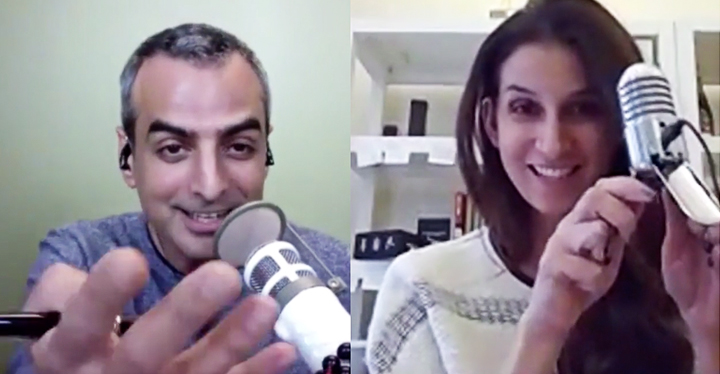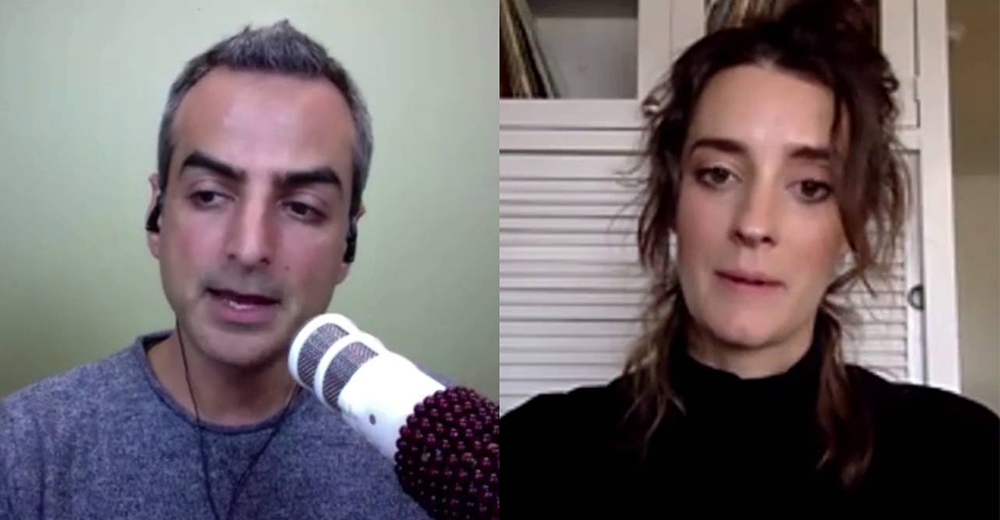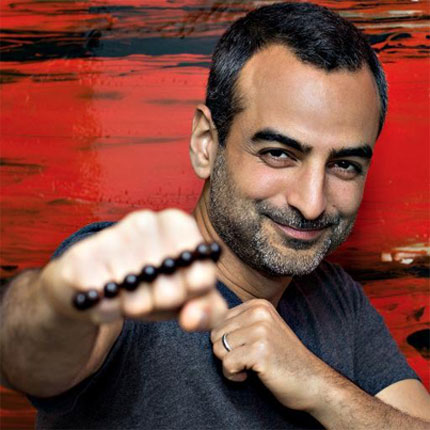INTRODUCTION
In his twenties, Andrew Warner burned out while building his first multi-million dollar company.
He wanted his experience with his next venture, Mixergy, to be different. Designed as a place where entrepreneurs could arrive and be creative—to be cool again—he set about integrating systems and policies that would prevent certain disasters. And that’s when he realized he was headed down the same path. Andrew knew something had to change.
Can Andrew find the balance between creativity and bureaucracy? Can he stop worry about everything and instead, start worrying about the right things? Creating the perfect system can be a painful process for founders. Mixergy helps you avoid the bumps and bruises of entrepreneurship… use Andrew’s story as your guide for building systems.
Story Contents
Never Not-Publish
Andrew Warner "never not published". If his readers expected a podcast, he'd have a podcast ready for them. He didn't need systems to make it happen. And, with his past experience as a business owner, he was wary of doing anything big that could limit his team at Mixergy. But then the unthinkable happens.
Worst Fear Confirmed
Lightning strikes twice. Andrew decides to start pursuing systems for Mixergy, cautiously at first. His slow-and-steady approach soon develops into an aggressive onslaught of systemization after yet another borderline disaster while processing podcasts. But the new routines might be wearing down on the team...
Remodel Needed
Mixergy’s existing systems have become entrenched, and Andrew fears counter-productivity. The question is whether the new systems have become too big to change. Andrew needs to decide between staying static, or making uncomfortable changes. Mixergy's future outlook may hang in the balance.
part one
Are systems killers of creativity or essential safety belts to keep creativity on track?
Systems hadn’t really crossed Andrew’s mind in years.
There was a time, running his first multimillion-dollar business, when Andrew obsessed over them. He went as far as having his own mother implement a system for handling checks… when they only received three a week. That sort of fixation turned his business into a job. He burned out, and cashed out.


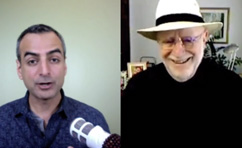
“I wasn’t building a company, I was building a glorified job for myself.”—Andrew
Some entrepreneurs wear their “workaholic” label as a badge of honor. But at what cost? Are 80-hour weeks really the way to growth... or the opposite?
Sitting back and wondering what went wrong, he reminisced of his New York childhood, surrounded by millionaires—his childhood heroes—creators who built industries, and themselves, up from nothing. He built his first business and, by the time it ended, saw the East Coast approach to entrepreneurship as a bureaucratic nightmare. After years of roving, Mixergy ended up in a different location, a different mindset: San Francisco.
Years later, Andrew was out running when systems crossed his mind again.
He was listening to Stephen King’s On Writing, and building systems wasn’t his goal. Interviews were Mixergy’s bread and butter, their most popular content and the best way for Andrew to reach his audience. A podcast full of fluff couldn’t accomplish his goals, so he was always looking for ways to juice as much meaning from them as possible. His audience wanted more from Mixergy. More importantly, so did Andrew. Stephen King, was an ideal source for suggestions. They included implementing systems—the author’s included writing 2,000 words daily.
The jump from traditional office entrepreneur to all-star interviewer had already been quite the evolution.
Andrew wasn’t naturally upfront and eager. He spent the first few decades of his life shy, bombing his first few conference speaking engagements. He had to change shirts after his first few interviews from the nervous sweat running down to his armpits. He hadn’t forgotten those times, because the difficulty of stepping behind a mic remained real.
“In short, the business system gives you a process to fix your processes."
—Michael Gerber
He foresaw failure back then, and it happened. Now, he foresaw success, and his interviews turned out alright.
But only alright. Foreseeing perfection was a tall order, and he leaned on experts like King to learn how they improved from good to great. King’s book touched a nerve when it touched upon the author’s personal system for crafting a narrative.
Andrew always looked to improve Mixergy. He hoped to learn as much from his interviews as his listeners did, but he was still wary of systemizing. He had tentative systems in place out of necessity, but he tried to avoid stifling creativity and office enjoyment.
The skyline of a magnificent city represents the successful architecture. Pudong has flourished in just a few decades.
Communist regimes rarely draw much praise for their aesthetic efforts (i.e. decades of “Maoist” simplicity), so it’s somewhat surprising to consider the awe-inspiring skyline of Pudong (the financial district of Shanghai). The Oriental Pearl Tower stands out but it cannot match the Shanghai Tower for eye appeal.
The world’s second-tallest building, Shanghai Tower was designed for greatness. They first laid out plans during 1993, when Pudong was established as a Special Economic Zone, a district operating under special regulations to boost industry. San Francisco’s Gensler architectural firm, noted for its bold resume, was hired to handle the tower—working alongside lead architect Jun Xia.
Calling the design "bold" is an understatement. The building spirals upward—the corkscrew created by a steel skeleton twisting 120 degrees as it rises. Both layers are completely transparent. These are functions as much as forms; the twist prevents wind impact on the structure by up to 25%, and the gap between glass layers makes cooling the occupied portion more efficient. Environmentally-friendly features abound.
"The Shanghai Tower represents a new way of defining and creating cities,” said Art Gensler, cofounder of the design firm. “By incorporating best practices in sustainability and high-performance design... Shanghai Tower redefines the role of tall buildings."
That makes Shanghai Tower perhaps the second-most relevant construct in Pudong, behind the Nanpu Bridge.
To be continued in Side Story 2 / 3...
Why have somebody else do it when you know what you want, and can just do it yourself?
Andrew was thrown for a loop when he interviewed Owen Enaowho
EPISODE #387 of SweetProcess. He was discussing his interview research process when Owen suggested changing the company culture at Mixergy. Let other people take care of these things, the guest suggested. No, Andrew asserted. He couldn't. A more professional rendition of “uh-huh”-”nuh-uh” ensued.
It was thinking like this that eventually led to disaster.
One day, when scheduled to record a podcast, he found he didn't even have an interview booked. And he never not-published. He had been doing this for years and never run into a problem. How was this possible?
Andrew had to scramble to find an interview, scramble to research for that interview, conduct the interview, edit and publish the interview, all on his own. He called his wife to let her know that he would be home late. She was pregnant with their first child, and he would be taking a month off when the baby arrived to help at home.
It got done. He never not-published. But he felt uncomfortable with the final podcast. The lack of research, the lack of a pre-interview... it came out. The product felt half-assed, although he had worked as hard as he ever had on a single podcast.
This couldn’t happen again. Something had to change if Mixergy was going to grow to meet its potential, to survive when he wasn’t there to watch over it.
He had to admit maybe Owen had a point.
part two
Searching for perfection is tough when you have this many imperfections on your hands.
Harold Mann EPISODE #616, CEO of Mann Consulting, lived through both the booms and busts of the Dotcom Era. His business saw unbelievable turnover—90 to 95%—as staff quickly took up better offers within the burgeoning internet industry. “We lost almost all of our corporate continuity, our folklore,” Mann recalled. “Nothing was passed down to the new generation of employees.”
The idea of starting from scratch hung over Andrew. He had a vision that—despite some of his monocentric work habits—didn’t stop with him. He wanted today’s listeners to be tomorrow’s guests, because they built successful companies using advice from Mixergy’s podcast. He wanted to make entrepreneurs cool again. According to high school students, YouTube influencers were cool, not entrepreneurs. Competing with YouTube stars for influence meant delivering consistent meaning.
“I’m a guy who read your book, who lived it, who taught it to my employees at the last company, and here I was making the mistake.”
—Andrew Warner
Mixergy's prime source of influence was the podcast. He knew he could pull more meaning from interviews if they became stories, and he used Joseph Campbell’s model of the “Hero’s Journey” to guarantee interviews became a meaningful story, and not just a handful of tips. At the same time, he realized some interviewees simply didn’t add up to his goals. He had come to realize that some interviewees simply didn’t add up to his goals. Even when the story fit within the frame of the Hero’s Journey, their delivery—he regretted to say—occasionally sucked. He didn’t want to risk a crappy interview.
And so he decided to implement a system for improving them.

Guest: Seth Godin

Guest: Seth Godin
Doing Failure the Right Way.
Seth Godin has failed more than most people, in his own words, and that’s a matter of pride for him. “Part of the rules of the game is ‘the person who fails the most wins,’” he said during New York City’s Advertising Week.
That advice comes with a huge asterisk, however: There is a right way, and a wrong way, to fail.
This means finding a “happy place” between failing big and not failing at all. Godin preaches that if you don’t fail at all, you can’t possibly be learning anything. But if you fail huge, you’ll never get the chance to fail again. For example, no one is looking to hire Kenneth Lay after he was done at Enron. Failing is fine, but only if you live to fail another day. “If you’re failing consistently in a way where you get to keep playing, that’s pretty cool,” Godin said during the same conference.
Many in the business world may be left wondering where exactly Godin’s own failures lie. He's sold businesses, and anything he writes is a "must-read" in entrepreneurial circles. But Godin has countless blog posts that you've never read, because he hasn't published them. Something, whether the content or quality of the writing, just doesn't feel right, so he shelves it. It's a waste of time, but it's better than letting a bad post water down the great stuff he does publish. Every failed post brings a new opportunity to ask himself why he had failed.
He knows there’s not a map, as he shared with Andrew during Episode 214. He studied generations of artists, trying to figure out if there was one. There wasn’t. Picasso, Dalí and Duchamp all attended art school to some degree and were successful in wildly different ways. The only thing they had in common were rejections, and failures.
Seth Godin probably wouldn’t mind being compared to Picasso in his field. But he knows he’s got a lot of failing to do before he gets there.
10 questions is a good start, but some problems simply don’t have good answers.
Andrew started simple.
He created a list of 10 questions his staff would ask during the pre-interview process, identifying what prompts brought out the best answers. Although he preferred to be the sole arbiter of system decisions, he took his buddy Ramit Sethi’s advice and set the questions within a Google Doc. He encouraged his team to make changes if they found a better way to elicit responses. Good teams share responsibility, right? They should probably share solutions too. He trusted them… almost as much as he trusted himself.
But for every item he could systemize for better results, he found something else to get worked up about. Audio quality, for example. He conducted almost all of his interviews by video calls, which meant relying on guests to have quality microphones, a sense for avoiding backlighting, and a quiet place to record. Andrew clenched his jaw during one recent interview, knowing the background noise at the guest’s office would distract from the excellent message. There was no way to fix problems taking place outside of Mixergy. He needed to go for a run.
If systems don’t immediately fix your issues, you should try obsession!
Andrew had done several marathons, but he also enjoyed running to blow off steam. If there was a podcast to be published, he wasn’t making anyone’s day better by glowering around the office. He hit the road and headed for a positive mental place. It was the same method he used to get comfortable before public speaking. No, the audio was not perfect, but the message on today’s podcast was good. Mixergy would recover. He would be fine.
A few miles on the road was good for an exhausted mind, but there was one thing it couldn’t fix: an unpublished podcast.
It came to Andrew’s attention, one year after the fact, his interview with appbackr founder Trevor Cornwell EPISODE #937 had never been published. It was just sitting there, on a computer, waiting for someone to notice… and no one had. Cornwell hadn’t reached out to ask, but surely someone—himself or a team member—must have realized nothing was published that day. How could this have happened? Where was the accountability?
It was all confirmation of Andrew’s worst fears, and one of Cornwell’s past quotes.
“You have to own, obsess, and be paranoid about every single step.”
Systems can be a great short-term solution for any office problem. But at what point do they become problems themselves?
Andrew woke up, breathing hard. It had been a nightmare, although he couldn’t recall details. His anxiety didn’t help with sleep.
The “lost interview” touched a nerve, bringing back Andrew’s hands-on side that needed control. Every published podcast came with suspicion that something was wrong. He nervously watched his system, ready to leap into action when a crack appeared. But he was also trying to push against forces that made his first venture miserable. He looked at his wife, still asleep. The looming birth of their child was another source of anxiety… or something deeper. Fear. Another series of factors he couldn’t control. Another set of expectations he could fail to live up to. What image was he setting for his son?
His interview with Tim Francis EPISODE #387 —a marketing rising star—offered clarity. Tim's vision was a call for entrepreneurs—for Andrew—to design and place systems guaranteeing business success. Andrew got to work.


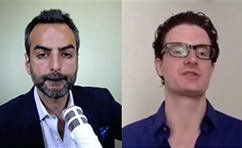
The Essentials
OK, so what goes into making a system? Over the years, Andrew’s guests have offered plenty of advice on the structure of an office system.
Much of Mixergy’s team worked remotely. Andrew flew them all in for a company retreat; he wanted them in the room for this meeting. It wasn’t a coffee-and-donuts affair—he booked a beautiful home, on a private beach with its own pool. But there was purpose.
They discussed the essentials of good systems, necessity of documentation, software that would best meet these needs and guarantee accountability. They returned from the retreat happy, and excited for the future of Mixergy.
And it was working. Every time someone noticed a potential improvement, it got added. One more bullet point closer to perfection. They told the stories of successful businesses but, maybe more importantly, they emulated those stories to accelerate Mixergy's growth.
The team had switched to Pipedrive to improve accountability. Rather than simply listing steps, Pipedrive required Mixergy staffers to shift projects through a kanban of tasks, affirming they had been completed.
At the base of every skyscraper is a much more mundane, and equally essential project.
The Nanpu Bridge is the most relevant construct in Pudong’s short history.
It’s not the prototype for skyscrapers of the future, like the Shanghai Tower. It doesn’t house institutions that make Pudong the financial capital of China. It’s actually the smallest of the four bridges connecting Pudong to east Shanghai.
But the Nanpu Bridge is the most relevant construct in Pudong’s history because it allowed all the others to take place.
City planners tend to work based on a vision, a design, we learned when we spoke with Alain Bertaud, a planner himself and author of Order Without Design. He insisted planners cannot work on vision alone, but must use indicators to choose the best course of action.
For the planners behind Pudong, that meant opening one bridge and seeing if developers flocked to the newly accessible land on the West side of the river.
Bertaud has three major indicators for urban planning. One is Floor Area Ratio (FAR), the total floor space measured against the amount of land a building is built upon. Previously, the ratio was low, as land was cheap and buildings were short. As demand increased, developers calculated how many floors they could build on a piece of land to best utilize their budget. As Pudong grew, buildings became taller, and the FAR rose... a positive reflection of good urban planning.
To be continued in Side Story 3 / 3...
Certain names can be tough to pronounce but the perfect process is even tougher to find.
Andrew's grand design was working. He had anticipated every circumstance—even his contingency plans had contingency plans. He was confident Mixergy was on the right path.
Until someone on his team mispronounced a guest's name.
The guest wasn't mad, and it had little impact on the final interview, but you never knew when it could be a problem. So, Andrew added another step to the pre-interview process, just in case. Another system set in place. Another system anticipating failure.
Andrew hesitated.
Was this step actually helping Mixergy achieve its goals? He counted the number of steps included within the pre-interview process. He suddenly realized how big it was. Big, but not necessarily strong. It was bloated. His stomach dropped. It was his first business, all over again.
The system didn’t look like the plan for a meaningful interview. It looked like a checklist, the kind hotel staff might check for every room they clean. No matter if he interviewed Warren Buffett or Jimmy Buffett, the list remained the same. An exercise in repetition. A bureaucracy. A chore.
Mixergy was becoming what Andrew had feared. Just a job.
part three
Better to dive right in than sit around and promise yourself that you’ll make necessary changes soon.
Andrew was out running again, a longer distance than he had planned. He had a lot to think about. The pre-interview system had too many steps and needed scaling back. He just didn’t know where to start. The biggest issue was Mixergy’s team had gotten used to it. It was entrenched.
A few listeners ragged on the quality of Mixergy's audio. Andrew knew Zoom was a better option; critics and customer reviews confirmed it. But his team had used Skype for years. They knew how to Skype. How could he expect them to stop and learn a new video service?
But Mixergy was constantly moving. There had never been a “good time” to learn a new system.
Andrew wasn’t fooling himself. He knew the longer they dug in their heels, the sooner Mixergy would become stale. Static systems would create a stale product. His viewers would find the next guy, the guy who had the crisp audio. Andrew knew he needed to adjust. He just didn’t know how.
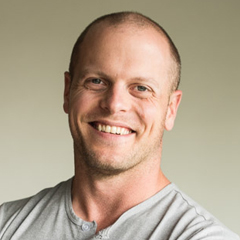
Guest: Tim Ferriss

Guest: Tim Ferriss
Beating Fear and Finding Time
Tim Ferriss was described as “the world’s best human guinea pig” by Newsweek, for attempting to master a variety of difficult (learning the Tagalog language) and occasionally dangerous (parkours) skills within a one-week period. “Mastery” is a strong word, but his system—or “toolkit,” as he calls it—has remarkable results. It’s counterintuitive to tell him that he shouldn’t, or can’t, to a task he sets his mind to.
But having his friends “throw water on you, and then call you on your own bullshit” is actually an essential part of his system.
Ferriss isn’t fearless. Before he gained renown for the aforementioned TV show, he had written several books following similar precepts, and from there he had taken chances with investing (worth a reported $100 million). And yet he feels the same anxiety as when he had relatively nothing. Money isn’t the issue and, to some degree, neither is his reputation. His friends are the first step in his system for overcoming himself. Next, he draws a three-column chart—listing the worst-case scenarios, what he could do to minimize the chance that he faces these scenarios, and how he can recover if the worst happens. And then he feels better.
His process is not awe-inspiring, and it won’t make for a best-selling book, like his The 4-Hour Chef and The 4-Hour Body. Becoming a chef or getting a beach body might take “4-hours” for Ferriss, but that’s because they’re complex tasks to begin with. Overcoming his anxiety is not a complex task, so he doesn’t overthink it. Like everything else, he dedicates only the time necessary. And that’s why he has the time to experiment with horseback archery and other adventures.
A good system doesn’t need to be complex. In fact, it shouldn’t be. Not because you’re lazy... but because you need time to figure out what you’re doing next.
He thought of what Derek Sivers EPISODE #565 would do. Sivers had founded the world’s largest indie music retailer and was the antithesis of complex systems. A famous anecdote was a customer’s response to the “What else can we do for you?” form field. They asked for a pack of gum. The warehouse worker was on his way to the store anyway, so they packed gum with the CD order. Sivers loved it, making “The Gum Parable” a core rule—basically the only rule—of his business.
Andrew pulled up in the middle of the sidewalk. “The Gum Parable” wasn’t a checkbox to include gum with every purchase. It represented the overarching moral to do anything within reason to please the customer. Sivers brought the concept of record stores to the internet age, and not through complex systems. He did it through the simplest rules possible.
“Then friends tell friends the parables of the business that communicate the philosophy, and then everybody knows.”
—Derek Sivers
“Check the pronunciation of a guest’s name” wasn’t a symbol for anything bigger. It had negligible impact on the quality of podcasts. It was just another checkbox on a bloated list. A list that was becoming monolithic, “too big to change,” but not too big to fail.
Mixergy needed to change in the future, but it also needed to change now.
Andrew had an idea, and it was more than just switching to Zoom.
The skyline of a magnificent city may be the sum of a city planner’s work, but they do not simply draw it out.
When someone has a vision of a metropolis, they rarely think about the number of bridges. But if the planners of Pudong had built skyscrapers first, there would be no businesses to fill them. And so they built a bridge instead. When that indicator flashed, they added accordingly. The Pudong skyline went from barely existing to being Shanghai’s signature skyline in just a few decades.
“Sometimes when I read the papers of my fellow urban planners,” Bertaud said. “I get the sense that they think cities are Disneyland or Club Med.” Attempting to design the perfect city is impossible under ever-changing circumstances, so plans are the next best thing. When circumstances change, tweaks are made. The result is never perfect, but constant review of indicators allow planners to improve the city and its systems. Indicators confirmed to Pudong’s planners the market would support developing the district, and they added more infrastructure accordingly.
City planners don’t design the skyscrapers you post photos of. They design the roads and public transportation systems you use to get there, and they do it slowly. They monitor changes in population density, and traffic, and they plan accordingly. It is beautiful in a way that might register with business owners like Andrew, if not the Instagramming public as a whole. This trend is repeated everywhere. The design gets the attention, and the essential system does not.

Too many people waste time trying to find the perfect answer. Find the right indicators first.
Today was Mixergy’s first monthly systems call.
Andrew realized Mixergy’s bloated systems hampered the team's ability to adapt. Improvements were delayed because people were busy juggling the system’s copious number of tasks. But Mixergy needed change. What tasks were truly pushing Mixergy toward its goals—educating and inspiring the next wave of successful entrepreneurs—and what tasks were distractions?



The CEO’s Role
If a CEO isn’t spending 80 hours-a-week making sure that the copier is functioning, what are they doing? Andrew’s guests weigh in.
Indicators would measure how the system was working—what needs added? What can be improved? What can be eliminated? The monthly systems call allowed them to put their minds together and smooth rough edges.
In short, they were determining how to run a successful business while it was running, instead of planning to avoid any failures.
The calls were like in-house podcasts for Mixergy itself.
The team had responded enthusiastically, and Andrew observed how it impacted their daily routines. He peeked his head in while his producer conducted a pre-interview. Last week she could have been reading from a script. Now, her enthusiasm for the interview sounded like she was running her own podcast.
“Start small, but look for signals that indicate you're moving toward your goals. For us, that meant identifying what grew our impact & what didn't.”
—Andrew Warner
Less chained to a system, the team moved more freely. Andrew knew this freedom would bring a new wave of ideas for Mixergy’s future. Their shared appreciation of the process was Andrew’s greatest indicator that Mixergy was on the right path.
Andrew sat at his desk, and checked attendance. He opened the call with a smile and a motto his team was well familiar with.
“Hello, Freedom Fighters.”
No one can give you a simple how-to on building systems for your business. Because it's your business, and there is none other like it.
But are you all on your own? No. Mentors—whether it be Andrew Warner or Andrew Carnegie—can provide valuable information, and point you in the right direction. When you apply that knowledge to your own situation, systems and successes will follow.
You'll experience failure. But if you set indicators to monitor your progress, you can identify what is working and what isn't. Always look for new information, and always experiment to find the best information, for your systems.
11 Past Mixergy Guests on What Indicators Make or Break Their Systems (PDF)
Instant Download
Thank you!
We’d love your feedback
Here’s your systems indicator PDF
Your PDF is right around the corner, but we’d like your feedback please. What did you think of the story? Are you going to start using systems?
You you are well on your way to improving systems in your company. Click the link below to get the free PDF.
11 Mixergy Guests on What Indicators Make or Break Their Systems (PDF)If you liked the story, please share it!
Get the Indicator PDF



